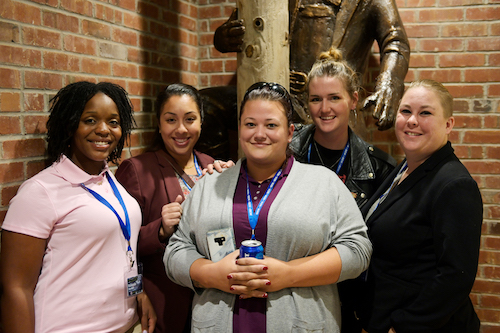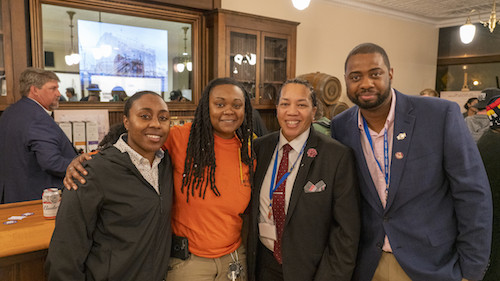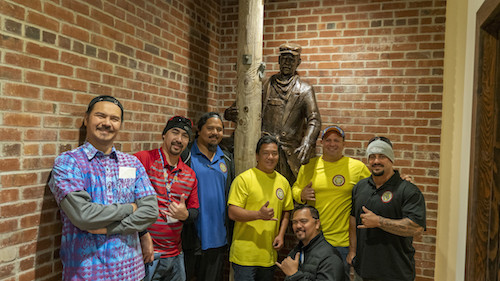Kevin Mack, a low voltage technician out of Detroit
Local 58, knew how everyone else in the room was feeling when they walked into
the St. Louis boarding house where Henry Miller and nine other delegates
founded the National Brotherhood of Electrical Workers in 1891.

|

|

|
| Young leaders of the IBEW came from every district in the U.S. and Canada to the birthplace of the Brotherhood in St. Louis for the fourth RENEW/NextGen Conference.
|
"It's overwhelming at first," Mack said. "This story, my life changing, my family's life changing, millions of lives changing because of what happened here, in this place. It's not just stories, and here I am. This place has an effect on people."
Mack was surrounded by members in town for the fourth Reach out and Engage NextGen Electrical Workers Conference and for most, this was their first visit to the birthplace of the brotherhood. This was the second time Mack, the RENEW/NextGen Advisory Council delegate from the Electrical Workers Minority Caucus, had been to the Henry Miller Museum; he was there in 2016 as an alternate to the IBEW's 39th International Convention when the boardinghouse-turned-museum first opened to the public.
And he knew, he said, what comes after the awe, and he was waiting for it.
"You get over 'This is where it started!' and then you see it is just a room. They weren't these big figures at that moment; they were just people who wanted better lives," Mack said. "They came together with an idea, and with a lot of effort, made the foundation for what we have today. That's inspiring. People who gave a damn, putting the effort in, created this and changed millions of lives. It's inspiring to think we can do the same."
Mack and hundreds of the brotherhood's young leaders came together to learn, share and plot future successes. And they did it all in the IBEW's birthplace, capped off with a celebration in the very building where the union was founded 127 years before.
"You aren't the IBEW leaders of the future anymore. You're the IBEW leaders of today," International President Lonnie R. Stephenson told them, noting that no generation in decades has faced the obstacles to joining the middle class that they have and, not coincidentally, that no age group has a higher approval of unions.
"Politicians and big-money special interests have thrown everything they can to stop young people from exercising their right to take collective action and join a union. The good news is that Millennials get it and they haven't stopped organizing," he said. "That's why, despite all the challenges in our way, I can't think of a more exciting time to be a young activist in the labor movement than now."
This year's conference offered opportunities for young activists to learn from one another, whether a local's RENEW/NextGen chapter is just getting off the ground or has been established for years.
"I want people to understand that you are not alone; you can answer someone else's questions and get your answers too, from your peers," said Civic and Community Engagement Department Director Tarn Goelling. "We are a big union. Every local has different circumstances, but someone here can help you find your way."
On the first day, more than 400 attendees participated in a massive clean-up of O'Fallon Park in north St. Louis.
"There are only a handful of park managers keeping watch over 125 acres, so you can imagine how grateful they were," said International Representative Areana Tate. "It's an example of the kind of thing RENEW/NextGen committees can easily accomplish back home.
"These are the go-getters, and we do have a lot of people getting in positions of power in their local, but mostly its rank-and-file," Tate said. "Organizing a park clean-up, running a food drive, these make a real difference, but they are also practice for union leadership: running organizing campaigns and getting contracts approved."
There were district meetings and workshops from Thursday afternoon, Oct. 17, through to the closing session Saturday morning. Workshop topics included everything from the structure of the IBEW, political organizing and voter registration strategies to prioritizing and time management.
Goelling said she received the most comments from attendees about a session called "Personal Is Powerful! Telling Your Story."
"All of our workshops were, 'You can do this now,'" Goelling said. "We are learning this together, but you have to feel brotherhood and sisterhood to live it."
Speakers included Missouri Senate Minority Leader Gina Walsh, Stephenson, Eleventh District International Vice President Curt Henke and Missouri AFL-CIO President Mike Louis.
St. Louis Local 1 Business Manager Frank Jacobs took the opportunity to remind everyone at the reception that fundraising for the museum is continuing and there are still many opportunities for locals and individuals to support the birthplace of the IBEW.
"The rooms and poles are all sponsored but there are still benches, custom brick pavers and places for the display of locals' emblems," Jacobs said. "This place was forgotten for a while and we want to make sure it never is again and stays an inspiration to our members."
There are also T-shirts and commemorative coins that individual members can buy that benefit the museum, he said. Anyone can come and visit the museum when they come through the city, he said.
"We have members stop by for tours nearly every day of the week," he said. "During normal business hours, we can open the gate and we will get a rep there in 10 to 15 minutes. But try and call ahead."
Donations can be made or items purchased via the museum's homepage. All revenue raised goes to the nonprofit Electrical Workers Historical Society, which owns and runs the museum.